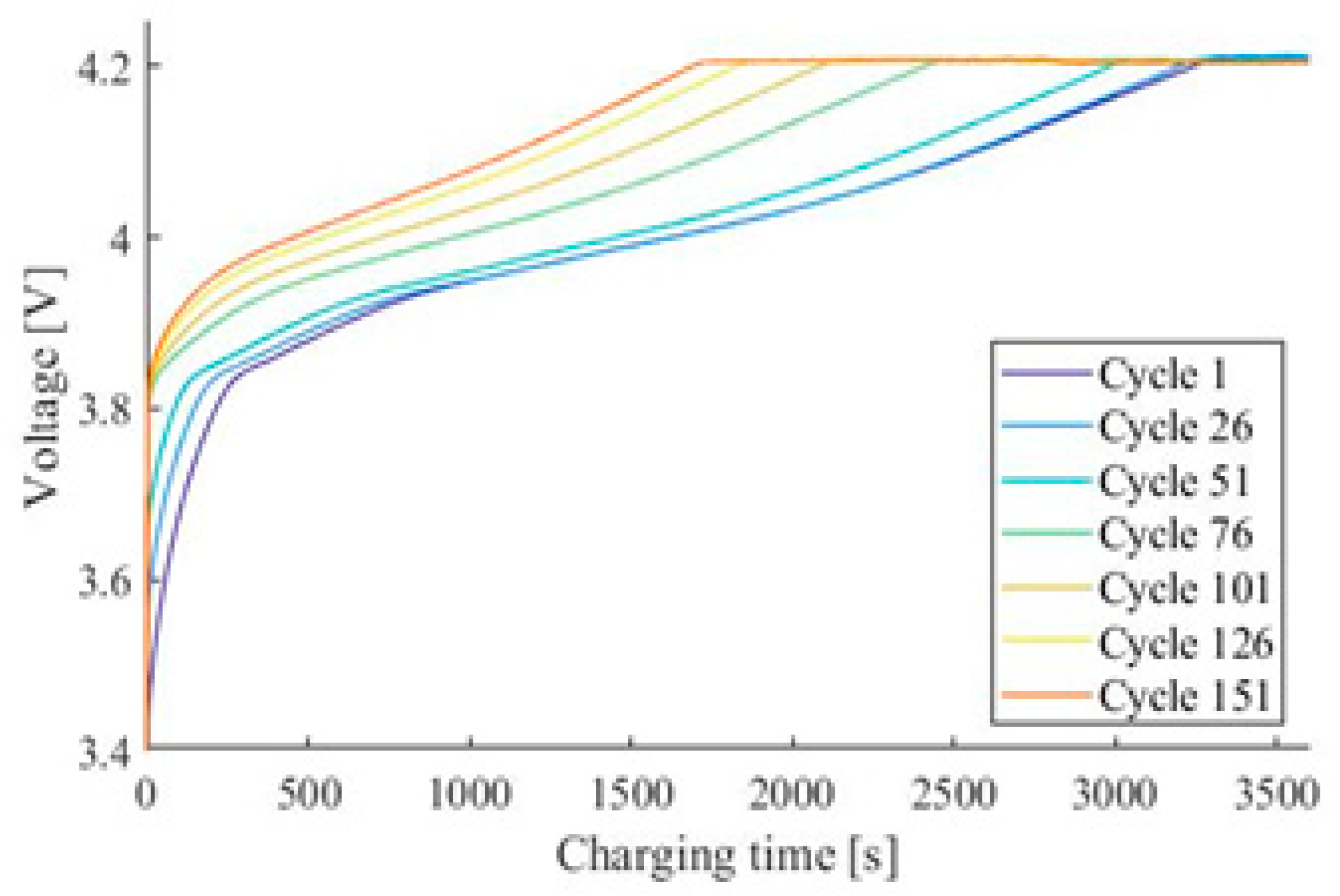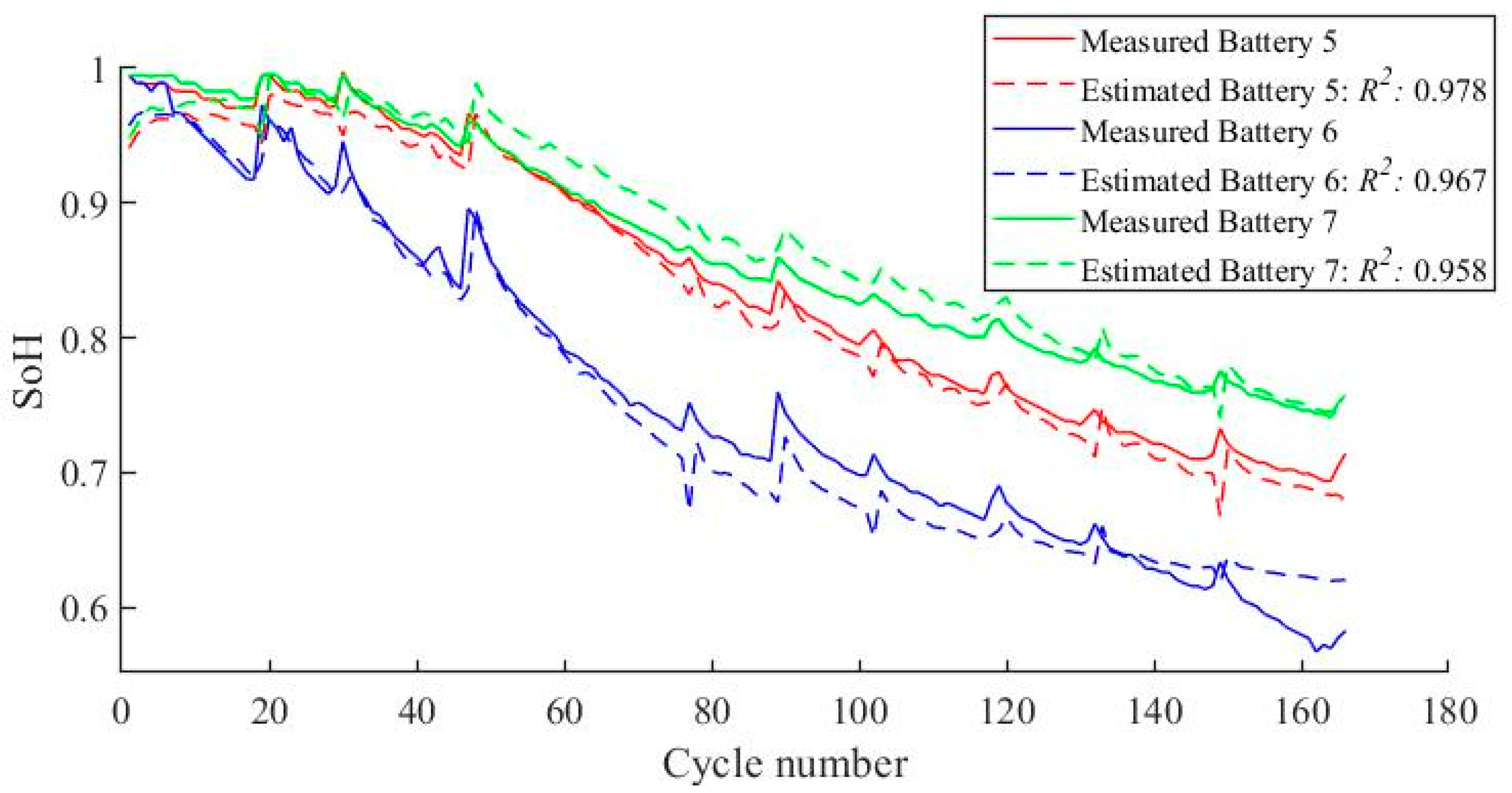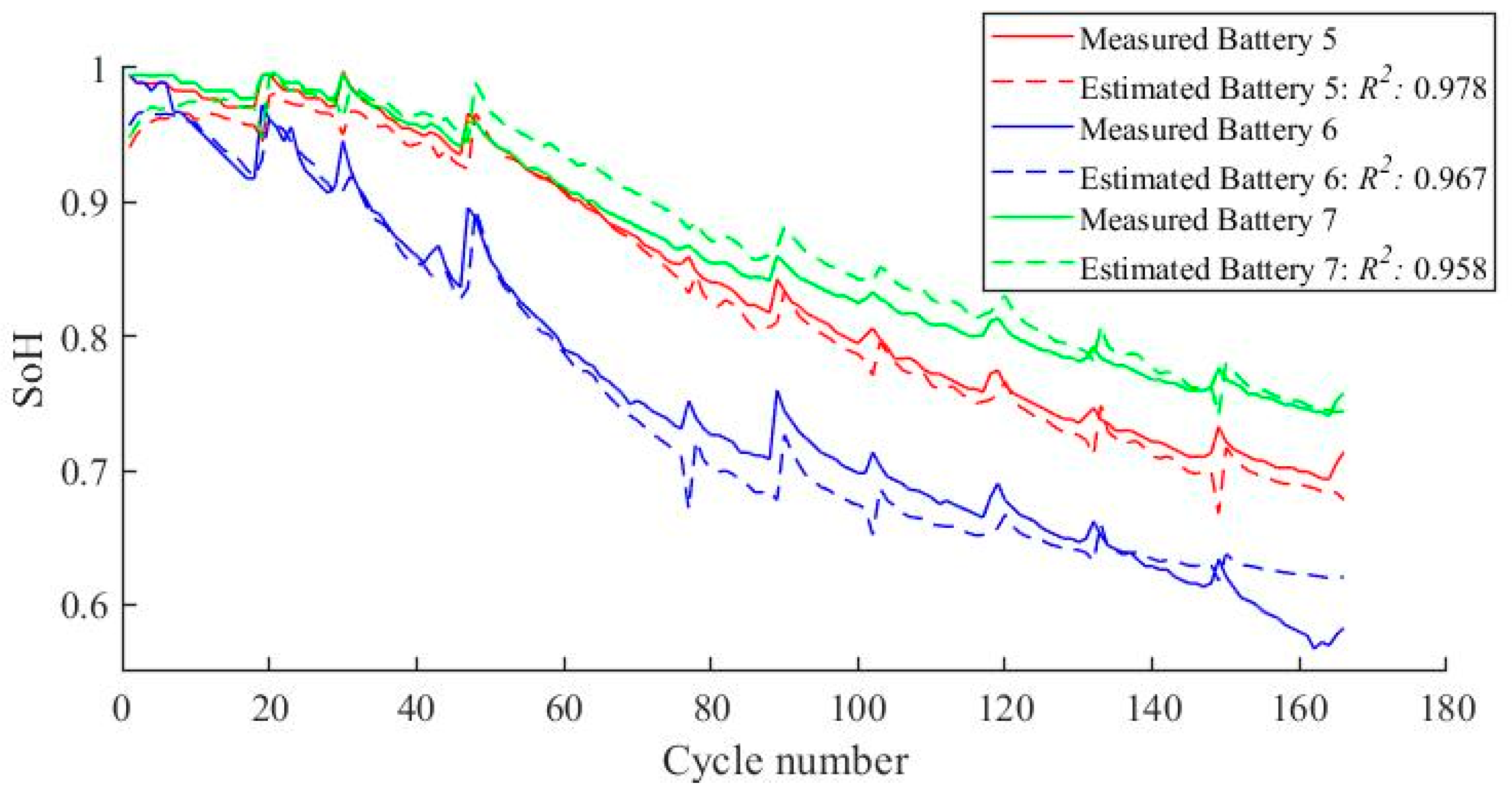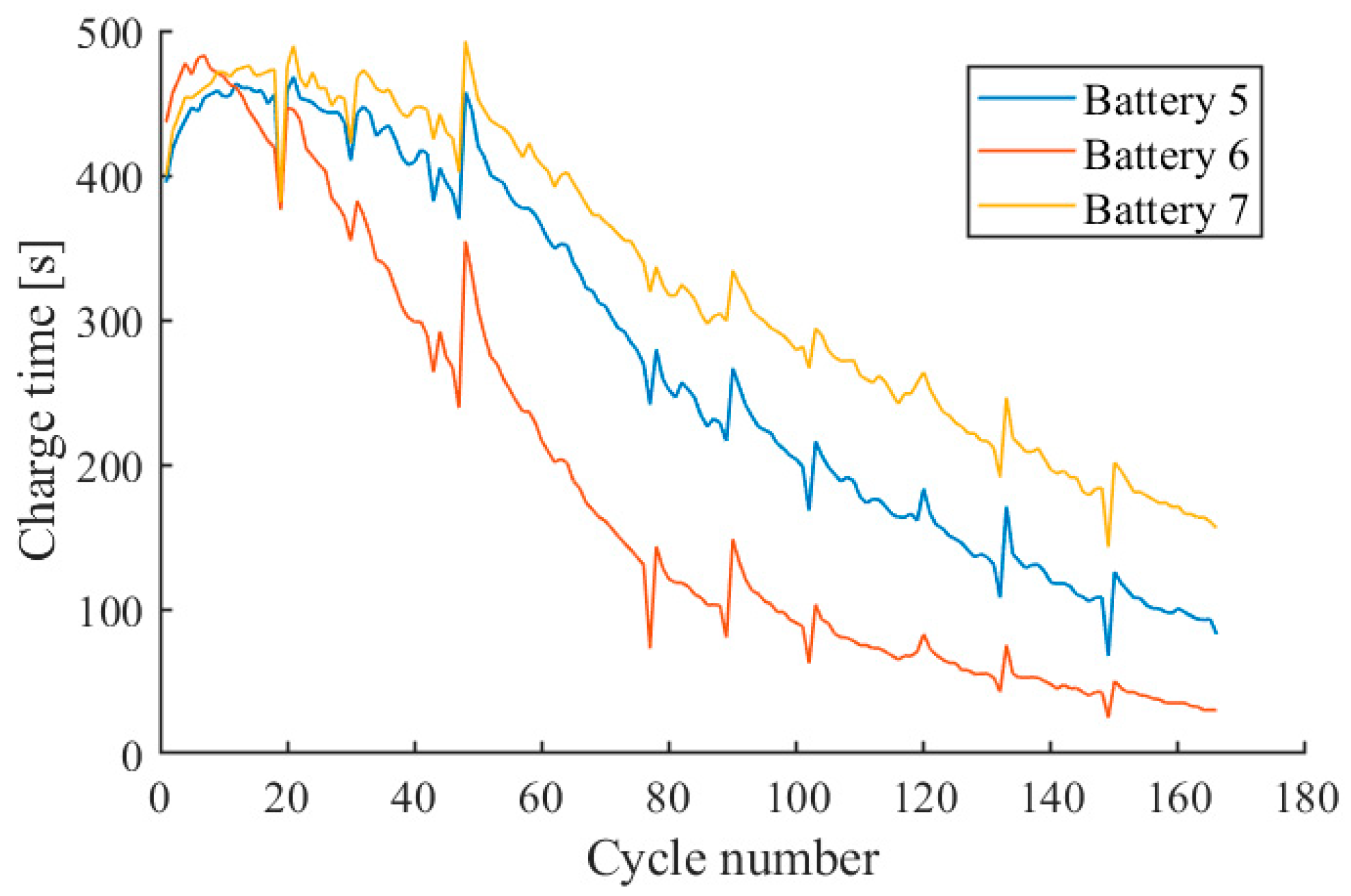Comparing Machine Learning Strategies for SoH Estimation of Lithium-Ion Batteries Using a Feature-Based Approach †
Abstract
1. Introduction
2. NASA Dataset
3. Considered Machine Learning Strategies
3.1. Multiple Linear Regression and Stepwise Regression
3.2. Support Vector Regression
3.3. Random Forest
4. Feature Selection
5. Results and Discussion
6. Conclusions
Author Contributions
Funding
Data Availability Statement
Conflicts of Interest
References
- Cristaldi, L.; Faifer, M.; Laurano, C.; Ottoboni, R.; Petkovski, E.; Toscani, S. Power Generation Control Algorithm for the Participation of Photovoltaic Panels in Network Stability. IEEE Trans. Instrum. Meas. 2023, 72, 1–9. [Google Scholar] [CrossRef]
- Pelletier, S.; Jabali, O.; Laporte, G.; Veneroni, M. Battery Degradation and Behaviour for Electric Vehicles: Review and Numerical Analyses of Several Models. Transp. Res. Part B Methodol. 2017, 103, 158–187. [Google Scholar] [CrossRef]
- Werling, T.; Geuting, P.; Höschele, P.; Ellersdorfer, C.; Sinz, W. Investigation of the Electro-Mechanical Behavior of Automotive High Voltage Busbars under Combined Electrical Load with Varying Indenter Geometry and Environmental Conditions. J. Energy Storage 2020, 32, 101861. [Google Scholar] [CrossRef]
- Campestrini, C.; Horsche, M.F.; Zilberman, I.; Heil, T.; Zimmermann, T.; Jossen, A. Validation and Benchmark Methods for Battery Management System Functionalities: State of Charge Estimation Algorithms. J. Energy Storage 2016, 7, 38–51. [Google Scholar] [CrossRef]
- Tanim, T.R.; Rahn, C.D.; Wang, C.Y. A Temperature Dependent, Single Particle, Lithium Ion Cell Model Including Electrolyte Diffusion. J. Dyn. Syst. Meas. Control Trans. ASME 2015, 137, 011005. [Google Scholar] [CrossRef]
- Li, X.; Fan, G.; Rizzoni, G.; Canova, M.; Zhu, C.; Wei, G. A Simplified Multi-Particle Model for Lithium Ion Batteries via a Predictor-Corrector Strategy and Quasi-Linearization. Energy 2016, 116, 154–169. [Google Scholar] [CrossRef]
- Petit, M.; Prada, E.; Sauvant-Moynot, V. Development of an Empirical Aging Model for Li-Ion Batteries and Application to Assess the Impact of Vehicle-to-Grid Strategies on Battery Lifetime. Appl. Energy 2016, 172, 398–407. [Google Scholar] [CrossRef]
- Barcellona, S.; Colnago, S.; Dotelli, G.; Latorrata, S.; Piegari, L. Aging Effect on the Variation of Li-Ion Battery Resistance as Function of Temperature and State of Charge. J. Energy Storage 2022, 50, 104658. [Google Scholar] [CrossRef]
- Xu, B.; Oudalov, A.; Ulbig, A.; Andersson, G.; Kirschen, D.S. Modeling of Lithium-Ion Battery Degradation for Cell Life Assessment. IEEE Trans. Smart Grid 2018, 9, 1131–1140. [Google Scholar] [CrossRef]
- Cui, Z.; Wang, C.; Gao, X.; Tian, S. State of Health Estimation for Lithium-Ion Battery Based on the Coupling-Loop Nonlinear Autoregressive with Exogenous Inputs Neural Network. Electrochim. Acta 2021, 393, 139047. [Google Scholar] [CrossRef]
- Liu, D.; Zhou, J.; Liao, H.; Peng, Y.; Peng, X. A Health Indicator Extraction and Optimization Framework for Lithium-Ion Battery Degradation Modeling and Prognostics. IEEE Trans. Syst. Man. Cybern. Syst. 2015, 45, 915–928. [Google Scholar] [CrossRef]
- Cao, M.; Zhang, T.; Wang, J.; Liu, Y. A Deep Belief Network Approach to Remaining Capacity Estimation for Lithium-Ion Batteries Based on Charging Process Features. J. Energy Storage 2022, 48, 103825. [Google Scholar] [CrossRef]
- Yang, D.; Zhang, X.; Pan, R.; Wang, Y.; Chen, Z. A Novel Gaussian Process Regression Model for State-of-Health Estimation of Lithium-Ion Battery Using Charging Curve. J. Power Sources 2018, 384, 387–395. [Google Scholar] [CrossRef]
- Feng, X.; Weng, C.; He, X.; Han, X.; Lu, L.; Ren, D.; Ouyang, M. Online State-of-Health Estimation for Li-Ion Battery Using Partial Charging Segment Based on Support Vector Machine. IEEE Trans. Veh. Technol. 2019, 68, 8583–8592. [Google Scholar] [CrossRef]
- Tian, J.; Xiong, R.; Yu, Q. Fractional-Order Model-Based Incremental Capacity Analysis for Degradation State Recognition of Lithium-Ion Batteries. IEEE Trans. Ind. Electron. 2019, 66, 1576–1584. [Google Scholar] [CrossRef]
- Ansean, D.; Garcia, V.M.; Gonzalez, M.; Blanco-Viejo, C.; Viera, J.C.; Pulido, Y.F.; Sanchez, L. Lithium-Ion Battery Degradation Indicators Via Incremental Capacity Analysis. IEEE Trans. Ind. Appl. 2019, 55, 2992–3002. [Google Scholar] [CrossRef]
- Stroe, D.I.; Schaltz, E. SOH Estimation of LMO/NMC-Based Electric Vehicle Lithium-Ion Batteries Using the Incremental Capacity Analysis Technique. In Proceedings of the 2018 IEEE Energy Conversion Congress and Exposition (ECCE), Portland, OR, USA, 23–27 September 2018; pp. 2720–2725. [Google Scholar] [CrossRef]
- He, J.; Wei, Z.; Bian, X.; Yan, F. State-of-Health Estimation of Lithium-Ion Batteries Using Incremental Capacity Analysis Based on Voltage-Capacity Model. IEEE Trans. Transp. Electrif. 2020, 6, 417–426. [Google Scholar] [CrossRef]
- Severson, K.A.; Attia, P.M.; Jin, N.; Perkins, N.; Jiang, B.; Yang, Z.; Chen, M.H.; Aykol, M.; Herring, P.K.; Fraggedakis, D.; et al. Data-Driven Prediction of Battery Cycle Life before Capacity Degradation. Nat. Energy 2019, 4, 383–391. [Google Scholar] [CrossRef]
- Barcellona, S.; Cristaldi, L.; Faifer, M.; Petkovski, E.; Piegari, L.; Toscani, S. State of Health Prediction of Lithium-Ion Batteries. In Proceedings of the 2021 IEEE International Workshop on Metrology for Industry 4.0 & IoT (MetroInd4.0&IoT), Virtual Event, 7–9 June 2021; pp. 12–17. [Google Scholar]
- Lashgari, F.; Petkovski, E.; Cristaldi, L. State of Health Analysis for Lithium-Ion Batteries Considering Temperature Effect. In Proceedings of the 2022 IEEE International Workshop on Metrology for Extended Reality, Artificial Intelligence and Neural Engineering, MetroXRAINE 2022—Proceedings, Rome, Italy, 26–28 October 2022; pp. 40–45. [Google Scholar] [CrossRef]
- Chen, C.; Pecht, M. Prognostics of Lithium-Ion Batteries Using Model-Based and Data-Driven Methods. In Proceedings of the IEEE 2012 Prognostics and System Health Management Conference, PHM-2012, Beijing, China, 23–25 May 2012; pp. 12–17. [Google Scholar] [CrossRef]
- Weng, C.; Cui, Y.; Sun, J.; Peng, H. On-Board State of Health Monitoring of Lithium-Ion Batteries Using Incremental Capacity Analysis with Support Vector Regression. J. Power Sources 2013, 235, 36–44. [Google Scholar] [CrossRef]
- Weng, C.; Sun, J.; Peng, H. Model Parametrization and Adaptation Based on the Invariance of Support Vectors with Applications to Battery State-of-Health Monitoring. IEEE Trans. Veh. Technol. 2015, 64, 3908–3917. [Google Scholar] [CrossRef]
- Chen, Z.; Sun, M.; Shu, X.; Shen, J.; Xiao, R. On-Board State of Health Estimation for Lithium-Ion Batteries Based on Random Forest. In Proceedings of the 2018 IEEE International Conference on Industrial Technology (ICIT), Lyon, France, 19–22 February 2018; pp. 1754–1759. [Google Scholar]
- Liu, K.; Li, Y.; Hu, X.; Lucu, M.; Widanage, W.D. Gaussian Process Regression with Automatic Relevance Determination Kernel for Calendar Aging Prediction of Lithium-Ion Batteries. IEEE Trans. Industr. Inform. 2020, 16, 3767–3777. [Google Scholar] [CrossRef]
- Su, X.; Sun, B.; Wang, J.; Zhang, W.; Ma, S.; He, X.; Ruan, H. Fast Capacity Estimation for Lithium-Ion Battery Based on Online Identification of Low-Frequency Electrochemical Impedance Spectroscopy and Gaussian Process Regression. Appl. Energy 2022, 322, 119516. [Google Scholar] [CrossRef]
- Tian, Y.; Dong, Q.; Tian, J.; Li, X.; Kukkapalli, V.K.; Kim, S.; Thomas, S.A. Capacity Estimation of Lithium-Ion Batteries Based on Multiple Small Voltage Sections and BP Neural Networks. Energies 2023, 16, 674. [Google Scholar] [CrossRef]
- Eddahech, A.; Briat, O.; Bertrand, N.; Delétage, J.Y.; Vinassa, J.M. Behavior and State-of-Health Monitoring of Li-Ion Batteries Using Impedance Spectroscopy and Recurrent Neural Networks. Int. J. Electr. Power Energy Syst. 2012, 42, 487–494. [Google Scholar] [CrossRef]
- Catelani, M.; Ciani, L.; Fantacci, R.; Patrizi, G.; Picano, B. Remaining Useful Life Estimation for Prognostics of Lithium-Ion Batteries Based on Recurrent Neural Network. IEEE Trans. Instrum. Meas. 2021, 70, 3524611. [Google Scholar] [CrossRef]
- Zhang, Y.; Xiong, R.; He, H.; Pecht, M.G. Long Short-Term Memory Recurrent Neural Network for Remaining Useful Life Prediction of Lithium-Ion Batteries. IEEE Trans. Veh. Technol. 2018, 67, 5695–5705. [Google Scholar] [CrossRef]
- Marri, I.; Petkovski, E.; Cristaldi, L.; Faifer, M. Battery Remaining Useful Life Prediction Supported by Long Short-Term Memory Neural Network. In Proceedings of the IEEE International Instrumentation and Measurement Technology Conference (I2MTC), Kuala Lumpur, Malaysia, 22–25 May 2023; pp. 1–6. [Google Scholar]
- Qu, J.; Liu, F.; Ma, Y.; Fan, J. A Neural-Network-Based Method for RUL Prediction and SOH Monitoring of Lithium-Ion Battery. IEEE Access 2019, 7, 87178–87191. [Google Scholar] [CrossRef]
- Marri, I.; Petkovski, E.; Cristaldi, L.; Faifer, M. Lithium-Ion Batteries Soh Estimation, Based on Support-Vector Regression and a Feature-Based Approach. In Proceedings of the 18th IMEKO TC10 Conference on Measurement for Diagnostic, Optimisation and Control to Support Sustainability and Resilience, Warsaw, Poland, 26–27 September 2022; pp. 109–113. [Google Scholar]
- Saha, B.; Goebel, K. Nasa Ames Prognostic Data Repository. NASA Ames Moffet Field, CA, USA. 2007. Available online: https://www.nasa.gov/content/prognostics-center-of-excellence-data-set-repository (accessed on 15 January 2022).
- Chen, Z.; Xia, X.; Sun, M.; Shen, J.; Xiao, R. State of Health Estimation of Lithium-Ion Batteries Based on Fixed Size LS-SVM. In Proceedings of the 2018 IEEE Vehicle Power and Propulsion Conference (VPPC), Chicago, IL, USA, 27–30 August 2018; pp. 1–6. [Google Scholar]
- Klass, V.; Behm, M.; Lindbergh, G. A Support Vector Machine-Based State-of-Health Estimation Method for Lithium-Ion Batteries under Electric Vehicle Operation. J. Power Sources 2014, 270, 262–272. [Google Scholar] [CrossRef]
- Li, Y.; Zou, C.; Berecibar, M.; Nanini-Maury, E.; Chan, J.C.W.; van den Bossche, P.; Van Mierlo, J.; Omar, N. Random Forest Regression for Online Capacity Estimation of Lithium-Ion Batteries. Appl. Energy 2018, 232, 197–210. [Google Scholar] [CrossRef]






| Hyperparameter | Value | |
|---|---|---|
| 1 | Box constraint | 0.1989 |
| 2 | Kernel scale | 11.55 |
| 3 | Epsilon | 0.030 |
| 4 | Kernel function | Linear |
| Feature Set | Voltage Range | Number of Features | |||||
|---|---|---|---|---|---|---|---|
| Linear Regression | Second-Degree Polynomial Regression | Third-Degree Polynomial Regression | SVR | Random Forest | |||
| A1 | 3.7–3.8 V | 1 | 0.538 | 0.595 | 0.631 | 0.613 | 0.660 |
| A2 | 3.8–3.9 V | 1 | 0.918 | 0.916 | 0.921 | 0.939 | 0.902 |
| A3 | 3.9–4 V | 1 | 0.947 | 0.927 | 0.930 | 0.963 | 0.904 |
| A4 | 4–4.1 V | 1 | 0.554 | 0.535 | / | 0.759 | 0.743 |
| A5 | 3.7–3.9 V | 2 | 0.901 | 0.897 | 0.894 | 0.917 | 0.838 |
| A6 | 3.8–4 V | 2 | 0.945 | 0.939 | 0.946 | 0.971 | 0.909 |
| A7 | 3.9–4.1 V | 2 | 0.942 | 0.835 | 0.652 | 0.961 | 0.877 |
| Feature Set | Voltage Range | Number of Features | |||||
|---|---|---|---|---|---|---|---|
| Linear Regression | Second-Degree Polynomial Regression | Third-Degree Polynomial Regression | SVR | Random Forest | |||
| B1 | 3.8–3.85 V | 1 | 0.781 | 0.896 | 0.897 | 0.810 | 0.878 |
| B2 | 3.85–3.9 V | 1 | 0.939 | 0.900 | 0.947 | 0.947 | 0.908 |
| B3 | 3.9–3.95 V | 1 | 0.937 | 0.918 | 0.916 | 0.949 | 0.896 |
| B4 | 3.95–4 V | 1 | 0.895 | 0.900 | 0.880 | 0.938 | 0.898 |
| B5 | 3.8–3.9 V | 2 | 0.931 | 0.909 | 0.928 | 0.941 | 0.901 |
| B6 | 3.85–3.95 V | 2 | 0.934 | 0.928 | 0.936 | 0.947 | 0.909 |
| B7 | 3.9–4 V | 2 | 0.950 | 0.912 | 0.922 | 0.968 | 0.903 |
| B8 | 3.75–3.9 V | 3 | 0.915 | 0.885 | 0.893 | 0.935 | 0.883 |
| B9 | 3.8–3.95 V | 3 | 0.899 | 0.911 | 0.895 | 0.948 | 0.905 |
| B10 | 3.85–4 V | 3 | 0.943 | 0.938 | 0.896 | 0.964 | 0.910 |
| B11 | 3.9–4.05 V | 3 | 0.939 | 0.756 | 0.884 | 0.962 | 0.898 |
| B12 | 3.8–4 V | 4 | 0.936 | 0.922 | 0.885 | 0.966 | 0.907 |
| B13 | 3.85–4.05 V | 4 | 0.931 | 0.864 | / | 0.958 | 0.911 |
| B14 | 3.9–4.1 V | 4 | 0.934 | 0.775 | / | 0.972 | 0.892 |
Disclaimer/Publisher’s Note: The statements, opinions and data contained in all publications are solely those of the individual author(s) and contributor(s) and not of MDPI and/or the editor(s). MDPI and/or the editor(s) disclaim responsibility for any injury to people or property resulting from any ideas, methods, instructions or products referred to in the content. |
© 2023 by the authors. Licensee MDPI, Basel, Switzerland. This article is an open access article distributed under the terms and conditions of the Creative Commons Attribution (CC BY) license (https://creativecommons.org/licenses/by/4.0/).
Share and Cite
Marri, I.; Petkovski, E.; Cristaldi, L.; Faifer, M. Comparing Machine Learning Strategies for SoH Estimation of Lithium-Ion Batteries Using a Feature-Based Approach. Energies 2023, 16, 4423. https://doi.org/10.3390/en16114423
Marri I, Petkovski E, Cristaldi L, Faifer M. Comparing Machine Learning Strategies for SoH Estimation of Lithium-Ion Batteries Using a Feature-Based Approach. Energies. 2023; 16(11):4423. https://doi.org/10.3390/en16114423
Chicago/Turabian StyleMarri, Iacopo, Emil Petkovski, Loredana Cristaldi, and Marco Faifer. 2023. "Comparing Machine Learning Strategies for SoH Estimation of Lithium-Ion Batteries Using a Feature-Based Approach" Energies 16, no. 11: 4423. https://doi.org/10.3390/en16114423
APA StyleMarri, I., Petkovski, E., Cristaldi, L., & Faifer, M. (2023). Comparing Machine Learning Strategies for SoH Estimation of Lithium-Ion Batteries Using a Feature-Based Approach. Energies, 16(11), 4423. https://doi.org/10.3390/en16114423








